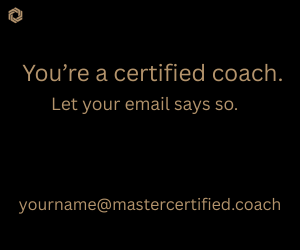No matter who you coach, what your niche is or why you got into the industry one thing always comes to mind at this time of year for those in the coaching industry: resolutions.
Setting goals and making resolutions for the new year is a rite of passage as each December comes and goes. Not only is this a great tool for self-motivation, but it also allows us to start the year with a sense of purpose and structure, making it more likely that our goals will become realities.
As a coach, you are no stranger to holding yourself to a high standard of accountability. Therefore, adopting a strategic approach to achieving your goals will likely come more naturally than it might for others. Setting goals for your professional outreach efforts, and strategies to meet those goals, is a great way to ensure the success of your coaching practice. The following steps can increase your confidence about achieving your objectives.
Step 1: Set a realistic goal
According to the third of the ICF Core Competencies, an ICF-credentialed coach is obligated to “partner with the client and relevant stakeholders to establish an overall coaching plan and goals.” In doing this for your own life, you are equipping yourself with the skills and self-reflection practices needed to set goals that elevate your current life, without being out of scope with reality.
While it is aspirational to set your sights high and reach for the stars, expecting too much almost always end in failure. Start small and work your way up to some of your longer-term or larger-scale goals. Begin by thinking about creating a social media presence for your brand, securing your first media interview, or honing your brand voice. All of these are eminently more achievable than, for example, tripling the size of your client base.
Step 2: Create a plan for achievement
Once you’ve identified your goals for the year, it’s time to create the strategy for achieving them. Similar to a coaching plan, your strategy should lay out a precise road map needed to reach the finish line.
Start by reflecting on what is needed to make your goal a reality. If you hope to create a social media presence for your brand, begin by listing everything you need to do to launch a successful social media profile. Whether this takes five steps or 50, arm your business with the work plan needed to reach success.
Step 3: Take it one step at a time
It’s easy to become hyper-focused on the end goal and lose track of the steps needed to get there. Often, people get ahead of themselves when building their New Year’s resolutions and end up rushing to the finish line. This can result in disappointment when they’re unable to instantly hit their goals. Instead, trust the work you put into step two, and follow the road map you carefully designed for yourself. In doing so, you will reach your goals much more efficiently. After all, Rome wasn’t built in a day.
That said, use time to your advantage. Research key dates that are relevant to your business goals and incorporate them into your social content. Setting goals is as much about strategy as it is about commitment. For example, ICF’s International Coaching Week takes place in May. Instead of launching your social media channels somewhat randomly, intentionally time your content calendar to ensure you’ve built a following by May, allowing yourself to leverage International Coaching Week as a way to attract even more followers in the community.
Step 4: Celebrate small wins along the way
Setting a long-term goal can feel disheartening when months pass and the end result still has yet to be achieved. As a coach, you know about mid-course frustrations and likely even remind your client of this reality. As is stated in the eighth of ICF’s Core Competencies, a large part of being an effective coach is celebrating progress and successes. By taking the time to applaud the small milestones you reach along the way, you are more likely to feel motivated to stick to your goals.
While setting your sights on gaining 100,000 followers by the end of the year might be your end-goal, celebrating your first 100, 1,000, and 10,000 followers will keep your motivation up and maintain your confidence in the ongoing process. In addition, you’ll be surprised at how many other people will applaud your seemingly small wins on the path to larger success.
Step 5: Continue to strive for more
Imagine it’s June, and lo and behold, you’ve already reached your lofty goal for the year. Does this mean you should stop and wait until next year to set new goals? Absolutely not!
Challenge yourself anew by aiming to reach another goal by the end of the year. Similar to the way you, as a coach, would ask your client powerful questions to help explore opportunities beyond their current thinking, ask yourself what else you can achieve that would continue your path to even greater success.
Your ability to achieve more for yourself and your coaching practice is not restrained by your original strategic plan for the year. While that plan served as a great way to hold yourself accountable, there is nothing holding you back from striving for more than you may previously have thought was possible.
Set Goals, But Don’t Stop There
As a coach, you spend your time advising, guiding and lending a helping hand to support your clients as they navigate their personal journeys to success. Whether their focus is on professional development, personal growth or financial freedom, you are the expert in asking the questions needed to light the fire that fuels their progress.
Ask yourself the same questions you ask your clients. Set your sights high and don’t limit yourself. The new year is an ideal time to identify your goals and create the strategies needed to achieve them, but life goes forward one day at a time. You are better equipped than anyone to find ways to use your entire year for the sake of attaining the best for yourself, your business, and your life.
Disclaimer
The views and opinions expressed in guest posts featured on this blog are those of the author and do not necessarily reflect the opinions and views of the International Coach Federation (ICF). The publication of a guest post on the ICF Blog does not equate to an ICF endorsement or guarantee of the products or services provided by the author.
Additionally, for the purpose of full disclosure and as a disclaimer of liability, this content was possibly generated using the assistance of an AI program. Its contents, either in whole or in part, have been reviewed and revised by a human. Nevertheless, the reader/user is responsible for verifying the information presented and should not rely upon this article or post as providing any specific professional advice or counsel. Its contents are provided “as is,” and ICF makes no representations or warranties as to its accuracy or completeness and to the fullest extent permitted by applicable law specifically disclaims any and all liability for any damages or injuries resulting from use of or reliance thereupon.
Authors
Post Type
Blog
Topic
Building a Successful Coaching Business, Business Development
Related Posts
The Executive Coaching Blueprint: Positioning, Pricing, and Performance
Transitioning from corporate to coach can feel like uncharted territory for many…
Why Coaches Need Other Coaches
Setting the Foundation When you’re learning about the field of coaching while…
Expanding Coaching Possibilities With the Coaching Spectrum Framework™
When I discovered coaching 14 years into my career as an occupational…








